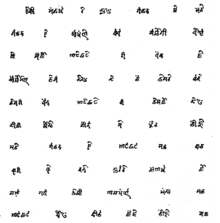|
Mandeali
Mandeali (Takri: 𑚢𑚘𑚶𑚖𑚮𑚣𑚭𑚥𑚯) is a Western Pahari language, spoken in northern India, predominantly in the Mandi district of Himachal Pradesh by the people of the Mandi Valley and particularly in the major city of Mandi. Other spellings for the name are Mandiyali and Mandiali. UNESCO reports it is one of the highly endangered languages of India.[3] Speakers of the dialect have decreased by 21% from 1961 to 2001. The language is distantly related to Kullvi. The Chambealic varieties are often considered separate languages, but at least some are 90–95% intelligible with Mandeali proper. Its sub-dialect are different than mandeali[4] DialectsPreliminary survey suggests speakers have functional intelligibility of Kangri. People in southeast Mandi district may have more difficulty understanding Kangri. Standard Mandeali is spoken throughout the broad valley running north and south from Jogindernagar to Sundarnagar. Mandeali Pahari is spoken north around Barot, east of Uhl River. Intelligible with difficulty to standard Mandeali. May be intermediate variety between Mandeali and Kullui. The dialect is very close to the Kullvi spoken in neighbouring lug valley region of Kullu district and are culturally, linguistically closer to Kullu. Southeast district contains transition to Mahasui. The dialect spoken is also sometimes referred as Suketi or dialect of Outer Seraj Area as dialect is an intermediate variety of Kullvi and Upper Mahasuvi of neighbouring Shimla and Kullu district. In the west, Sarkaghat is also a bit different from standard Mandeali, perhaps forming a transition towards Hamirpur and Bilaspur areas. Lexical similarity: 89% with Palampuri dialect of Kangri, 83% with Chambeali.[5] PhonologyConsonants
VowelsThe vowels of Mandeali language are shown below.
GrammarPronounsThe Pronouns of Mandeali for different person and number are - 1st Person Singular : हाऊँ/ɦaːũ/ 1st Person Plural : आस्से /asːe/ 2nd Person Singular : तू /tu/ 2nd Person Plural : तुस्से /t̪usːe/ 3rd Person Proximate Singular : ए, ये /eː, jeː/ 3rd Person Proximate Plural : यों /jõː/ 3rd Person Distal Singular : से /seː/ 3rd Person Distal Plural : स्यों /sjõː/ Noun Cases
1 घर - home - Nominative 2. घरो/ घरा जो - घर को - to home - Accusative 3. घरे - घर ने - Ergative 4. घरा के/ घरा कन्ने/ घरा साउगी- with house - Comitative 5. घरा ले/ घरा ला - घर से - through home - Instrumental 6. घरा कट्ठे - घर के लिए - for home - Dative 7. घरा ले/ घरा ला - घर से - from home - Ablative 8. घरा रा/रे/री - घर का/की/के - of home - Genetive
9. घरा/ घरा मंझ - घर में - Innesive 10. घरा गास, परयाल्हे, पर - घर पर - Addesive
11. घरा (sing)/ घरो (plural)- ओ घर - Vocative 12. घरा साँहीं - घर जैसा - Similative 13. घरा तिक्कर/ तिक - घर तक - Terminative Numerals
ScriptThe native script of the language is a variety of Takri called Mandeali Takri. Wiktionary has a category on Mandeali language.  VocabularyNames of monthsTraditionally, the month formats is based on Hindu calendar.
Names of daysDays are generally indic.
•Twār is a loan word from Urdu (Itwār) StatusThe language is commonly called Pahari or Himachali, just like many other neighbouring languages. The language has no official status. According to the United Nations Education, Scientific and Cultural Organisation (UNESCO), the language is of definitely endangered category, i.e. many Mandeali children are not learning Mandeali as their mother tongue anymore.[6] The demand for the inclusion of 'Pahari (Himachali)' under the Eight Schedule of the Constitution, which is supposed to represent multiple Pahari languages of Himachal Pradesh, had been made in the year 2010 by the state's Vidhan Sabha.[7] There has been no positive progress on this matter since then even when small organisations strive to save the language and demand it.[8] Due to political interest, the language is currently recorded as a dialect of Hindi,[9] even when having a poor mutual intelligibility with it and being close to other Pahari languages such as Kahluri and Kangri. References
|
|||||||||||||||||||||||||||||||||||||||||||||||||||||||||||||||||||||||||||||||||||||||||||||||||||||||||||||||||||||||||||||||||||||||||||||||||||||||||||||||||||||||||||||||||||||||||||||||||||||||||||||||||||||||||||||||||||||||||||||||||||||
Portal di Ensiklopedia Dunia
